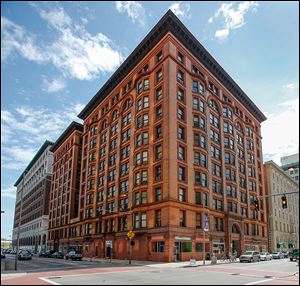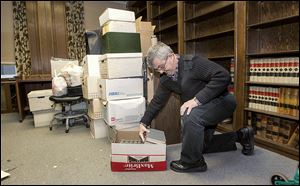
HISTORIC DOWNTOWN LANDMARK
Now-shuttered Spitzer Building marks era’s end
‘Grand dame’ once was hub of Toledo’s legal community
12/2/2013
Spitzer
THE BLADE
Buy This Image

Spitzer
Not even cheap rents, cozy atmosphere, and personal attention to tenants’ needs could keep downtown Toledo’s grand dame alive.
The Spitzer Building, the one-time hub of Toledo’s legal community, closed Sunday, turning the historic landmark at Madison Avenue and Huron Street into 10 stories of emptiness and ending a 12-decade relationship with the central business district.
Tenants, including some who had been there for decades, began moving to other downtown locations shortly after Patrice Spitzer tearfully announced in late September the building would soon close.
PHOTO GALLERY: Click here to view related images
Mrs. Spitzer is the court-appointed receiver of the foreclosed building and daughter-in-law of the late John B. Spitzer, whose family had controlled the building for all but the last five years of its 117-year existence.
“I am trying not to cry,” Mrs. Spitzer said as she worked in the manager’s office of the silent building. “That is what I am trying to do.”
Built at a cost of $500,000, the Spitzer Building is believed to be the city’s first sizable structure with a metal skeleton. Its red terra cotta ornamentation, brick facade, bay windows, and arched Madison entrance mimic the style of Chicago’s turn-of-the-century skyscrapers designed by famed architect Louis Sullivan.

The Spitzer Building’s ground-floor arcade is thought to be the city of Toledo’s first enclosed shopping mall.
Cousins A.L. Spitzer and Ceilan M. Spitzer, both capitalists and investment bankers, hired local architects Bacon and Huber to design the building, constructed between 1893 and 1896. Its success prompted the cousins to enlarge the building with construction of a 10-story addition along Huron Street four years later.
The cousins started construction in 1905 on the 18-story Nicholas Building, which they named after their grandfather, Nicholas Spitzer. For reasons that are forgotten or unknown, the Spitzers eventually ended their partnership; A.L. Spitzer took ownership of the Spitzer Building and Ceilan Spitzer gained control of the Nicholas.
Perhaps more than any of the skyscrapers on Madison, the Spitzer Building has maintained its original turn-of-the century design.
Polished mahogany still gleams on stairway railings, ornate knobs and scrollwork trim on door hardware hasn't been touched, and marble still covers the walls in hallways that lead to about 640 offices and cubicles.
The U-shaped building’s rows of original wood-framed windows remain functional and are a gateway for natural light.
“It’s a wonderful building. You can see what it was like at one time, with the marble and wood,” said Dave Mittelstaedt, a lawyer who had practiced in the Spitzer for 30 years.
The ground-floor arcade, which once filled with natural light from glass ceiling panels, was the building’s heart. Through the years, restaurants, coffee shops, jewelry stores, drug stores, dress and card shops, and hair salons held residence among the arcade’s 25 shops and seven counters, considered to be the first enclosed mall in Toledo.
In addition to the many law offices, tenants have included insurance agencies, accountants, stock brokers, custom jewelers, tailors, employment agencies, and mortgage offices. At one time, three beauty shops were found in the upper floors.
“You knew when it was Perm Day because you could smell it,” Mrs. Spitzer said.
Mr. Mittelstaedt said he will miss having his law office in the Spitzer Building in part because of the stock of lawyers with encyclopedic knowledge.
“We are kind of like a family here. Everybody knows everybody,” he said. “You can always knock on somebody’s door and ask them questions.”
The Spitzer Building Co. sold the building to a private-equity group headed by Koray Ergur of San Francisco in 2008, and filed foreclosure action against the company in Lucas County Common Pleas Court on Jan. 24, 2011.
In deciding to close, Mrs. Spitzer cited a falling occupancy rate, expenses for maintenance and repairs, and additional staff needed for fire safety checks mandated after the building’s alarm system failed.
Tenants admitted the building is less than perfect now.
Elevators are sometimes slow, if they work at all; toilets don’t always flush, and heating and cooling were inadequate at times. But the imperfections were tolerated or accepted because of inexpensive rents and the late John Spitzer’s direct involvement in managing the building and personal attention to tenants’ needs.
“John Spitzer, as long as I can remember, was the world’s best landlord. He was wonderful. He accommodated everybody,” said Robert Kaplan, a lawyer who also rented there for many years. “He cared about the building, and he cared about the tenants.”
Mr. Spitzer, a lawyer and anti-trust expert, businessman, and grandson of A.L. Spitzer, died on Nov. 18, 2011. He was president of the former Spitzer Paper Box Co. and was a fixture at the Spitzer Building.
Mr. Kaplan said Mr. Spitzer allowed long-term tenants to rent space on year-to-year leases without signing a new lease.
“We trusted them because they wanted the building to be perfect. Not because the lease required it,” he said. “It is the end of an era and nothing will ever compare.”

Dave Mittelstaedt packs up books in his office at the Spitzer Building. He practiced law there for 30 years and valued having other lawyers nearby if he had questions.
Except for a two-year absence, a member of the Kaplan family practiced law in the Spitzer Building from the 1920s until six months ago.
After graduating from law school in 1954, Mr. Kaplan joined his father, Samuel Z. Kaplan, who began his law career in the Spitzer as an associate with Marshall and Frazier, a law firm that formed the foundations for Marshall & Melhorn and Shumaker, Loop & Kendrick. Mr. Kaplan’s son, Sam Kaplan, joined the firm in the early 1990s.
Paul Frankel, also a longtime tenant, said the people — especially their intellects — were what distinguished the Spitzer Building.
“It was like a village,” he said. “It was an eclectic group of people. It was fun.”
Sharon Cummings moved her business, the Downtown Print Shop, from the basement of the neighboring Gardner Building to the Spitzer arcade in 1984. Last week, she moved the store back to the basement in the Gardner.
Ms. Cummings said many of the tenants and even some customers had become like family.
“This is so sad. I am not a city girl. I am a small-town girl. Downtown was the most small downtown place in Toledo, especially in the arcade. But now we are all split up,” she said. “I am going to miss everybody.”
Contact Mark Reiter at: markreiter@theblade.com or 419-724-6199.